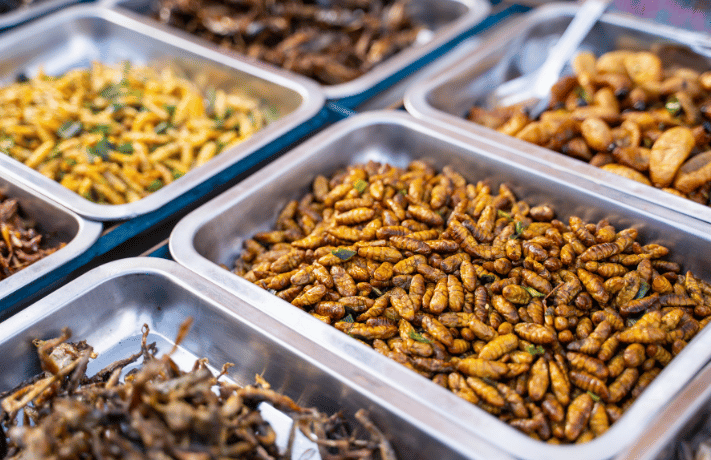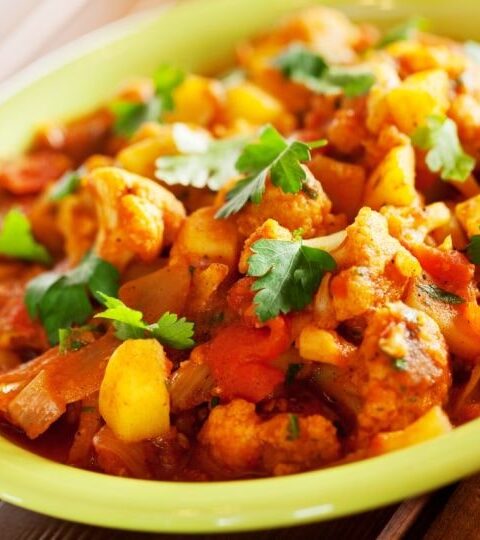Traveling and tasting go hand in hand because many of us visit new places merely to try local cuisine. But what if you stumble upon something that tastes entirely different from the foods that you usually eat—something bizarre, distasteful, or even worse—like red ant chutney? Along with delicious and tempting foods, the world is also home to some unusual delicacies that you can encounter on your next trip.
So if you’re a person who enjoys challenging your palates, then explore the top 10 countries with the weirdest foods; you never know what you might find there—your muffled yuck or unexpected yum. But before we start, prepare for them mentally before indulging yourself in something your stomach can’t tolerate. What is holding you back if you are geared up? Keep on reading!
- Fried Tarantulas, Cambodia
- White Ant Egg Soup, Laos
- Jellied Moose Nose, Canada
- Casu Marzu, Italy
- Century Eggs, China
- Huitlacoche, Mexico
- Balut, Philippines
- Shirako, Japan
- Sannakji, South Korea
- Chaprah, India
1. Fried Tarantulas, Cambodia:

Do you have Arachnophobia? Tarantulas are dangerous and poisonous, but did you know that some people consider them to be a delicacy? Yes, in the Skuon town of Cambodia, roasted tarantulas are indeed quite popular. They are either coated with sugar or garlic and sold by street sellers, or they are marinated in MSG (monosodium glutamate, a flavor booster), sugar, and salt before being fried with garlic until they are perfectly crispy and served with a sauce to dip in. These delectable snacks, additionally known as “a-ping spiders” or “edible spiders,” have a flavor similar to crab or fried chicken. Due to a lack of food during the Khmer Rouge period, these unusual dishes were first launched as food and have now become tasty treats all over the world. In order to destroy parasites, they need to be cooked over a hot flame or deep-fry, so if you’re a novice taster, make sure that the venom has been removed. In addition, its body as well as legs are the best portions to eat, whereas the abdomen has a bitter taste.
2. White Ant Egg Soup, Laos:

Do you intend to move from your usual diet and yearning to dine on something different, healthiest, and strangest? Then this traditional and weirdest food, white ant egg soup from Thailand and Northern Lao (a country in Asia), will be a perfect choice for you. Gaeng Kai Mot Daeng, also known as ant egg soup, is prepared by combining white ants, their eggs, and embryos with other ingredients like basil leaves, garlic, galangal (Thai ginger), and more. A few young ants are added to this soup to increase its sourness, and many people from different countries love the flavor of these tiny shrimp-like tastes. In the past, weaver ants, also referred to as red ants, were used in Thailand to prepare them. They explode inside your mouth while offering a nutty, flavorful, and acidic tang with a large dose of protein. Already mouthwatering? Your next taste-travel list should add this delicacy!
3. Jellied Moose Nose, Canada:
Of course, everyone uses their noses to breathe. Would you believe me if I said that you can intake the “nose of an animal” which is used for inhaling? Indeed, during the 1830s, when animals were hunted down and every body part was being utilized, some unique tasters from Alaska and Canada’s north decided to munch on the long snouts of these moose. This traditional Canadian cuisine, featured in the Northern Cookbook (the Government’s official publication made in 1967), is boiled with onions, herbs, and spices, again boiled, diced, and finally coated with gelatinous broth for molding them into jelly. Please take note that before cooking, the moose’s nose hair needs to be removed from them. A distinctive, chewy, soft, and gelatinous dining containing supplies of protein, iron, and zinc, jellied moose nose is a two-in-one dish that is both nourishing and unusual to try.
4. Casu Marzu, Italy:
Have you ever heard that the most well-known food in the world is food that has been spoiled or rotten? A typical Pecorino cheese from the Sardinia island of Italy, Casu Marzu is prepared from sheep’s milk that contains live maggots. In order for cheeseflies (Piophila casei) to lay eggs, hatch the maggots that dig around them, and digest the fats to increase their taste into soft-creamy, the cheese is cut open at the top and placed in a darkened room for months. Since these live maggots can withstand stomach acid and cause intestinal sores, bloody stool, and excess vomit when consumed, this noxious cheese is prohibited in numerous countries. It is occasionally referred to as “rotten cheese,” “maggot cheese,” or “the forbidden cheese” and has a world record with Guinness for “the most dangerous cheese.” However, whether you decide to eat them with maggots or without maggots, is completely up to you. (Keeping them in the refrigerator will kill the little creatures.)
5. Century eggs, China:

If you come across a rotting egg, will you eat it? The answer is unambiguously “YES” for many explorers. Despite not being ages old, these eggs are rotten enough to qualify as an unusual food around the world. In order to get the desired taste, colour, and texture, duck, goose, chicken, as well as quail eggs have been preserved for just a few months with a combination of clay, ash, salt, or quicklime. During this process, the white layer develops into a dark brown, visible jelly, while the yolk shifts to a dark green, grey, or even black colour and a slimy texture. They frequently go by the names millennium eggs, 100 or 1000 years old, skin eggs, or preserved eggs. Iron and protein are abundant in these eggs, despite their sulphur and ammonia odor. It is not required to cook these century eggs because you can simply peel or wash away the outer covering, and small bites work better than pieces to enjoy the taste. Due to the abundance of sodium in this egg, higher blood pressure may result.
6. Huitlacoche, Mexico:

While some other countries view them as crop damage, Mexico considers them as weird food with distinctive and peculiar flavours. Huitlacoche is a type of corncob fungus that converts ordinary corn ears along with kernels to blue-black tumor growths. It also goes by the names Mexican truffle as well as corn smut or mushroom. The fungus develops as the corn ripens, and infected maize yields more proteins, vitamins, and two essential amino acids than healthy corn. It can also be utilized medicinally. To fully enjoy its earthy, woodsy, smokey, sweet, mushroom- or corn-like flavor, it should be harvested when it is spongy and soft. Additionally, it tastes similar to black truffle.
7. Balut, Philippines:

Balut, a notorious street food in the Philippines, is another egg delicacy that is disgusting and unappetizing. It is simply an odd-looking dish prepared from fertilized duck eggs, which are then incubated for a span of 2-3 weeks to produce a partially developed duckling, then boiled while alive. To consume them, all you need to do is poke a hole in the top layer of the shell, gulp the flavorful liquid, and then grind the remaining parts—feathers, embryos, and bones—with salt, chili, and vinegar. It is risk-free for you to eat, and it even offers a high level of calcium, calories, and protein that contribute to its nutritional benefits.
8. Shirako, Japan:

Shirako, a Japanese delicacy that translates to “white children,” is made from the sperm bags (reproductive organs) of fishes such as cod, salmon, puffer fish, angler fish, and squid. The sacs have a reputation for their sweet custardy taste and aroma of fresh seafood, which are steamed or roasted in tempura batter and often eaten raw. Its texture is gentle, gooey, and creamy, while this is typically white or pink coloured and resembles tiny, tube-shaped brains. This strange snack, known as “Milt” in English, has a lot of good protein sources that help the body’s tissues heal in addition to omega-3 fatty acids.
9. Sannakji, South Korea:

This South Korean cuisine will undoubtedly make your stomach twist if this top list of the weirdest foods in each country doesn’t. A delicacy called “Sannakji” is made by chopping the tentacles of a fresh, writhing baby octopus and serving it with sesame oil and their seeds. They are made particularly from long-arm octopus and mini octopus known as “Nakji” or “Baby octopus” which have a pure ocean aroma, slimy, chewable texture, and subtle taste. Despite the fact that the chef kills the sea creature before serving, it still gets nerve activity, allowing the suction cup-equipped tentacles to squirm and get stuck in your throat, which will cause you to choke to death. These are regarded as one of the riskier foods for humans because of the choking danger, which results in the deaths of 6 people each year. Tempted? Try them out at your own peril, and if you do, be sure to chew them properly!
10. Chaprah, India:
Since we were little, we have believed that red ants are dangerous because their bites lead to itching pain and discomfort. But what would you do if I told you that you could eat delicious chutney made with ants in India? In Indian states like Chhattisgarh, Odisha, and Jharkhand, Chaprah, commonly referred to as red ant chutney, is a side dish produced with certain red ants and their eggs. Red ants are crushed down, dried out, and grinded in a mortar and pestle with salt, a little sugar, chilli, and other ingredients to create an orange paste. This crunchy-crispy chutney has a salty, sour, and spicy flavor and has medicinal values for relieving stomach problems. They are sold by vendors in local marketplaces, wrapped in sal leaves. (Note: The ant’s excess formic acid becomes the spiciest when combined with seasonings, which are not suitable for non-spicers.)
If you enjoyed reading about the top 10 weirdest foods in the world and would like to learn more about foods, travel, haunted places, love, and animals, check out this Kintop10 website for more top 10 information. If you’re planning a trip, unveil the pleasantly surprising flavors of these unusual foods during your upcoming holidays, and comment on the most bizarre food you’ve ever tried.








Your blog is a hidden gem.